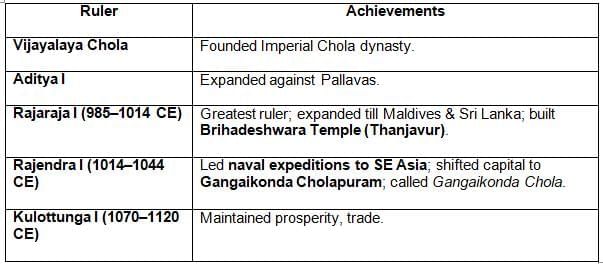SSC CGL Exam > SSC CGL Notes > General Awareness for SSC CGL > Cheat Sheet: Cholas and Other South Indian Kingdoms
Cheat Sheet: Cholas and Other South Indian Kingdoms | General Awareness for SSC CGL PDF Download
Major South Indian Dynasties
- Cholas (c. 9th–13th century CE, greatest Tamil power)
- Pallavas (4th–9th century CE, Kanchipuram)
- Chalukyas (6th–12th century CE, Badami & later Kalyani)
- Rashtrakutas (8th–10th century CE, Manyakheta)
- Pandyas (Madurai)
- Cheras (Kerala)
The Cholas (Most Important)
Rise:
- Early Cholas mentioned in Sangam Literature.
- Vijayalaya Chola (9th c. CE) – Founder of Imperial Cholas (capital → Thanjavur).
- Expanded under Rajaraja I (985–1014 CE) and Rajendra I (1014–1044 CE).
Key Rulers

Administration
- Highly organized → village self-government (Sabha, Ur, Nagaram).
- Revenue from land, trade, ports.
- Strong naval power → control over Indian Ocean trade.
Economy & Culture
- Agriculture (Cauvery delta = “Rice bowl of South”).
- Trade with SE Asia, China, Arabia.
- Temples = economic & cultural centers.
- Architecture: Dravidian style – Brihadeshwara (Thanjavur), Gangaikonda Cholapuram, Airavateswara.
- Literature: Tamil flourished; patronage to Shaivism & Vaishnavism.
Pallavas (4th–9th c. CE)
- Capital: Kanchipuram.
- Famous Rulers:
- Mahendravarman I – built rock-cut temples.
- Narasimhavarman I (Mamalla) – defeated Pulakeshin II; built Shore Temple & Pancha Rathas(Mahabalipuram).
- Contribution: Started structural Dravidian temples (stone, not caves).
Chalukyas (6th–12th c. CE)
- Capital: Badami (Vatapi), later Kalyani.
- Famous Rulers:
- Pulakeshin II (610–642 CE) – defeated Harsha on Narmada; described in Aihole Inscription (Ravikirti).
- Rivalry with Pallavas.
- Contribution: Rock-cut temples at Badami, Aihole, Pattadakal.
Rashtrakutas (8th–10th c. CE)
- Capital: Manyakheta.
- Famous Rulers:
- Dantidurga – founder.
- Amoghavarsha I – patron of literature (Kavirajamarga in Kannada).
- Krishna I – built Kailasa Temple at Ellora.
Pandyas
- Capital: Madurai.
- Ancient Sangam age rulers revived in early medieval times.
- Patronized Tamil literature, Meenakshi Temple traditions.
Cheras
- Region: Kerala.
- Known for trade with Romans (spices, pepper).
- Symbol: Bow and arrow.
The document Cheat Sheet: Cholas and Other South Indian Kingdoms | General Awareness for SSC CGL is a part of the SSC CGL Course General Awareness for SSC CGL.
All you need of SSC CGL at this link: SSC CGL
|
528 videos|2108 docs|339 tests
|
FAQs on Cheat Sheet: Cholas and Other South Indian Kingdoms - General Awareness for SSC CGL
| 1. What were the key features of the administration system in the Chola dynasty? |  |
Ans. The Chola dynasty had a well-organized administrative system characterized by a centralized government. The king was the supreme authority, supported by a council of ministers. The empire was divided into provinces called 'mandalams', which were further divided into 'valanadus' and 'nadus'. Local self-governance was encouraged through village assemblies, known as 'sabhas', which played a crucial role in local administration. The Cholas also maintained an efficient revenue system, collecting taxes from agriculture, trade, and crafts.
| 2. How did the economy of the Chola dynasty thrive during its reign? |  |
Ans. The Chola dynasty had a thriving economy driven by agriculture, trade, and commerce. The fertile lands of the region supported extensive agricultural production, including rice, sugarcane, and spices. The Cholas were also known for their maritime trade, establishing trade routes with Southeast Asia, which facilitated the exchange of goods such as textiles, spices, and precious stones. Additionally, they promoted crafts and industries, leading to a prosperous economy.
| 3. What contributions did the Pallavas make to South Indian culture? |  |
Ans. The Pallavas were significant contributors to South Indian culture, particularly in art and architecture. They are renowned for their rock-cut temples and monumental architecture, with the most famous examples being the Shore Temple at Mahabalipuram and the Kailasanathar Temple at Kanchipuram. The Pallavas also played a key role in promoting Tamil literature and the Sanskrit language. Their patronage of the arts led to the flourishing of sculpture, dance, and music during their reign.
| 4. What was the significance of the Chalukyas during their period of rule? |  |
Ans. The Chalukyas were significant for their contributions to architecture, art, and political consolidation in South India. They are known for the construction of remarkable temples, such as the Badami Cave Temples and the Virupaksha Temple in Pattadakal, which showcase a blend of architectural styles. The Chalukyas also established a strong centralized government and played a crucial role in the cultural and political landscape of South India, influencing subsequent dynasties.
| 5. How did the Pandyas contribute to trade and commerce in ancient South India? |  |
Ans. The Pandyas were known for their active participation in trade and commerce, particularly during their golden age. They established trade routes that connected South India with the Mediterranean and Southeast Asia. The Pandyas traded spices, pearls, textiles, and other goods, which contributed to their wealth and prosperity. Their capital, Madurai, became a bustling trade center, attracting merchants from various regions, which further enhanced their economic and cultural significance.
Related Searches




















